
Shareholder Letter Q3 2022
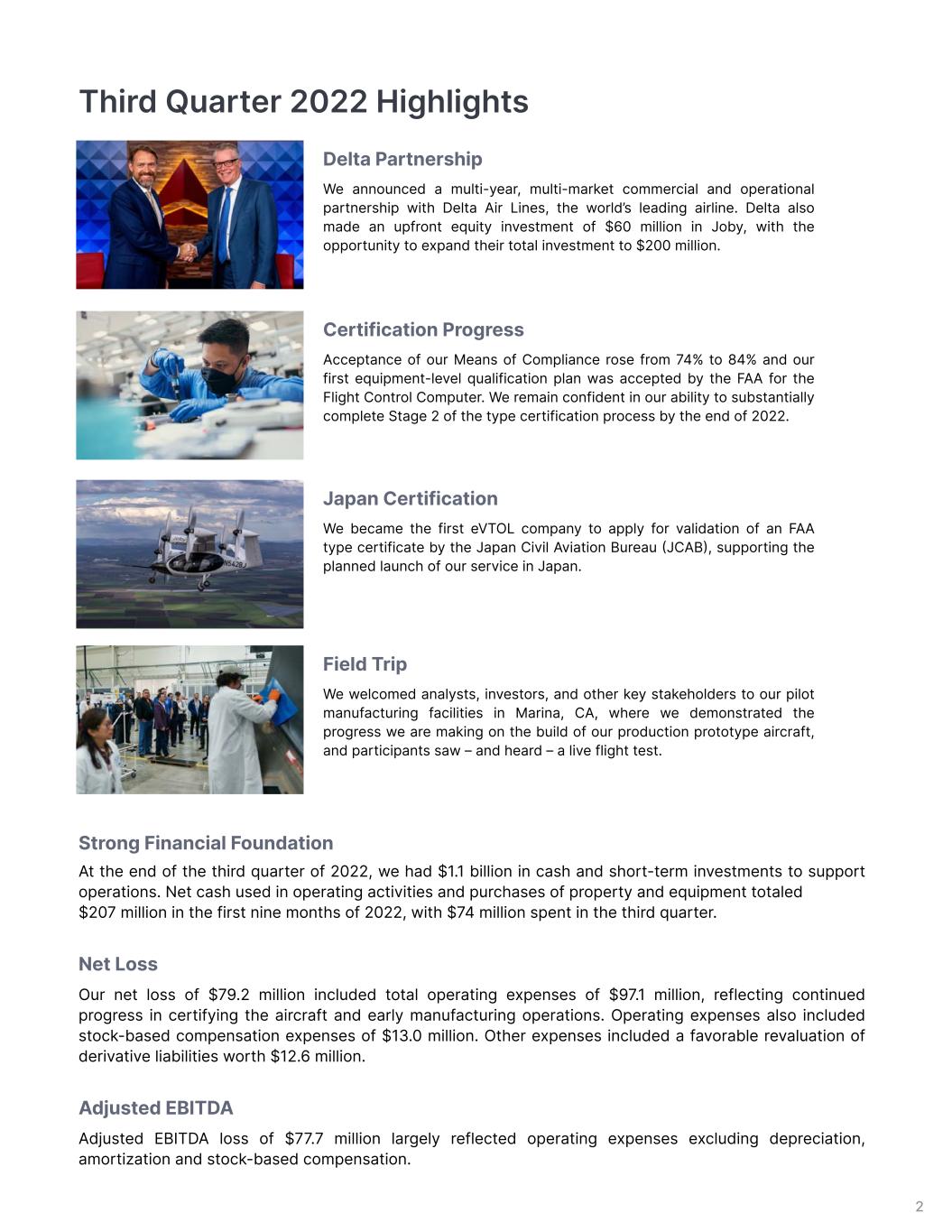
Third Quarter 2022 Highlights Delta Partnership We announced a multi-year, multi-market commercial and operational partnership with Delta Air Lines, the world’s leading airline. Delta also made an upfront equity investment of $60 million in Joby, with the opportunity to expand their total investment to $200 million. Japan Certification We became the first eVTOL company to apply for validation of an FAA type certificate by the Japan Civil Aviation Bureau (JCAB), supporting the planned launch of our service in Japan. Certification Progress Acceptance of our Means of Compliance rose from 74% to 84% and our first equipment-level qualification plan was accepted by the FAA for the Flight Control Computer. We remain confident in our ability to substantially complete Stage 2 of the type certification process by the end of 2022. Strong Financial Foundation At the end of the third quarter of 2022, we had $1.1 billion in cash and short-term investments to support operations. Net cash used in operating activities and purchases of property and equipment totaled $207 million in the first nine months of 2022, with $74 million spent in the third quarter. Net Loss Our net loss of $79.2 million included total operating expenses of $97.1 million, reflecting continued progress in certifying the aircraft and early manufacturing operations. Operating expenses also included stock-based compensation expenses of $13.0 million. Other expenses included a favorable revaluation of derivative liabilities worth $12.6 million. Adjusted EBITDA Adjusted EBITDA loss of $77.7 million largely reflected operating expenses excluding depreciation, amortization and stock-based compensation. 2 Field Trip We welcomed analysts, investors, and other key stakeholders to our pilot manufacturing facilities in Marina, CA, where we demonstrated the progress we are making on the build of our production prototype aircraft, and participants saw – and heard – a live flight test.

Progress On Our Long-Term Plan Certifying our Aircraft The percentage of our Means of Compliance accepted by the Federal Aviation Administration (“FAA”) rose from 74% to 84% during the third quarter, putting us in a strong position to substantially complete Stage 2 of the certification process - as defined in our Q2 2022 Letter to Shareholders - by the end of the calendar year. One additional Area-Specific Certification Plan (“ASCP”) was submitted during the quarter, bringing the total submitted to four. We also submitted our first equipment-level qualification plan during the quarter. The plan focuses on the verification of the environmental and operational capabilities of our Flight Control Computer and was recently accepted by the FAA, enabling us to proceed with for-credit qualification testing. Our progress on Stage 4 moved from 7% to 13%. We continue to generate significant amounts of data on the performance of our aircraft, regularly flying several hours per day across numerous flights. We have now flown more than 10,000 nautical miles with our pre-production prototype aircraft since 2019, recording more flight hours and miles flown in October than in any previous month. This flight data is critical to tuning our test facilities and ensuring our production aircraft is optimized to meet certification and program goals. As we intend to do each quarter, we have provided an update on our progress across all five stages of certification below. Based on our progress to date and estimated work ahead, along with the expected late-2024 delivery of the relevant FAA operational regulations, followed by type certification, we now expect to start commercial passenger service in 2025. We continue to anticipate beginning initial service operations in 2024 with the U.S. Department of Defense. 3 100% 96% 84% 94% 37% 13% 4% Stage 1 Certification Basis Stage 2 Means of Compliance Stage 3 Certification Plans Stage 4 Testing & Analysis Stage 5 Show & Verify JOBY FAA 100% 1% 0% Joby’s Progress to Type Certification (Q3 2022)

Scaling our Manufacturing A wide range of investors and analysts were able to visit our pilot production plant in Marina, CA, in October as part of our inaugural Field Trip event. Guests were able to see the progress we have made across all the major aerostructures for our first production-intent aircraft, as well as the additional composite structures we have produced for our second and third production-intent aircraft and to support testing. During the event, we also displayed numerous production-intent actuation, energy management, and flight electronics assemblies built at our San Carlos facility, including a completely integrated propul- sion system. Many of these assemblies are now undergoing testing as we prepare to integrate them into our production-intent aircraft later in 2022. We continue to plan for future growth and are actively evaluating proposals from a number of states, including California, to support the construction of our higher- volume, Phase 1 production facility. Preparing for Commercial Operations In October, we announced a multi-market, multi-year partnership with Delta Air Lines, the world’s leading airline. As part of the first-of-its-kind arrangement, the companies will work together to integrate a Joby- operated service into Delta’s customer-facing channels, providing Delta customers the opportunity to reserve a seat for seamless journeys to and from city airports when booking through Delta, with New York and Los Angeles highlighted as target markets for initial commercial operations. Following Delta’s upfront equity investment of $60 million in Joby, the airline will have the opportunity to invest an additional $140 million in two stages based on the completion of key milestones. The payments received from the exercise of warrants will provide additional capital to Joby’s balance sheet. The partnership will be mutually exclusive across the U.S. and U.K. for five years following commercial launch, with the potential to extend that period. We took an important step forward in our relationship with Uber, expanding our 2020 agreement to integrate our respective services into each other’s apps globally, meaning we’ll be able to deliver seamless, multimodal journeys in international markets throughout the world. We also formally applied for our aircraft to be certified for use in Japan, following an agreement between U.S. and Japanese regulators to streamline the type certificate validation process for eVTOL aircraft. The application builds on Joby’s long-standing ties with Japan, having welcomed Toyota as a strategic partner in 2018 and entered into partnership with ANA Holdings Inc., Japan's largest airline, earlier this year. We announced a similar approach to certification in the U.K. earlier this year. 4
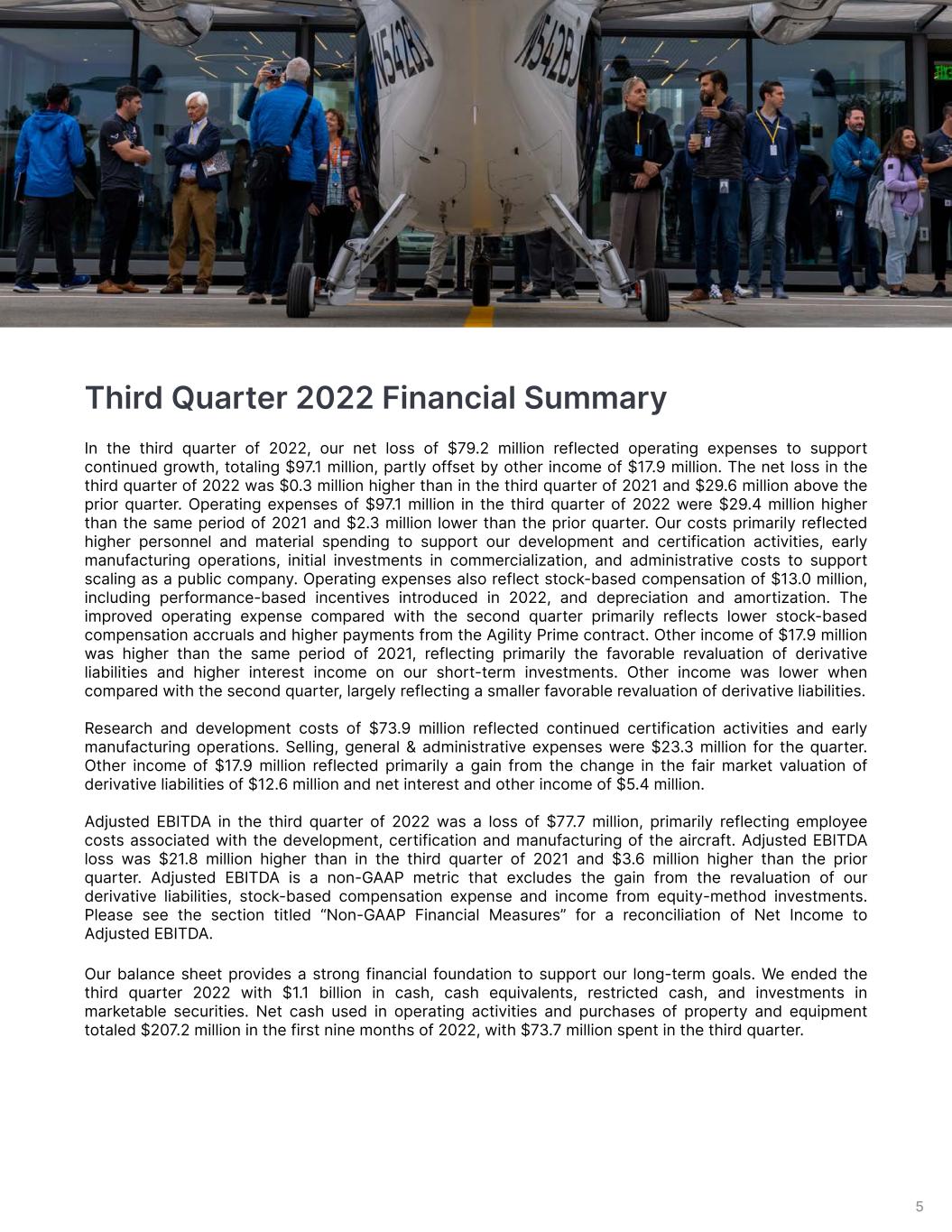
Third Quarter 2022 Financial Summary In the third quarter of 2022, our net loss of $79.2 million reflected operating expenses to support continued growth, totaling $97.1 million, partly offset by other income of $17.9 million. The net loss in the third quarter of 2022 was $0.3 million higher than in the third quarter of 2021 and $29.6 million above the prior quarter. Operating expenses of $97.1 million in the third quarter of 2022 were $29.4 million higher than the same period of 2021 and $2.3 million lower than the prior quarter. Our costs primarily reflected higher personnel and material spending to support our development and certification activities, early manufacturing operations, initial investments in commercialization, and administrative costs to support scaling as a public company. Operating expenses also reflect stock-based compensation of $13.0 million, including performance-based incentives introduced in 2022, and depreciation and amortization. The improved operating expense compared with the second quarter primarily reflects lower stock-based compensation accruals and higher payments from the Agility Prime contract. Other income of $17.9 million was higher than the same period of 2021, reflecting primarily the favorable revaluation of derivative liabilities and higher interest income on our short-term investments. Other income was lower when compared with the second quarter, largely reflecting a smaller favorable revaluation of derivative liabilities. Research and development costs of $73.9 million reflected continued certification activities and early manufacturing operations. Selling, general & administrative expenses were $23.3 million for the quarter. Other income of $17.9 million reflected primarily a gain from the change in the fair market valuation of derivative liabilities of $12.6 million and net interest and other income of $5.4 million. Adjusted EBITDA in the third quarter of 2022 was a loss of $77.7 million, primarily reflecting employee costs associated with the development, certification and manufacturing of the aircraft. Adjusted EBITDA loss was $21.8 million higher than in the third quarter of 2021 and $3.6 million higher than the prior quarter. Adjusted EBITDA is a non-GAAP metric that excludes the gain from the revaluation of our derivative liabilities, stock-based compensation expense and income from equity-method investments. Please see the section titled “Non-GAAP Financial Measures” for a reconciliation of Net Income to Adjusted EBITDA. Our balance sheet provides a strong financial foundation to support our long-term goals. We ended the third quarter 2022 with $1.1 billion in cash, cash equivalents, restricted cash, and investments in marketable securities. Net cash used in operating activities and purchases of property and equipment totaled $207.2 million in the first nine months of 2022, with $73.7 million spent in the third quarter. 5
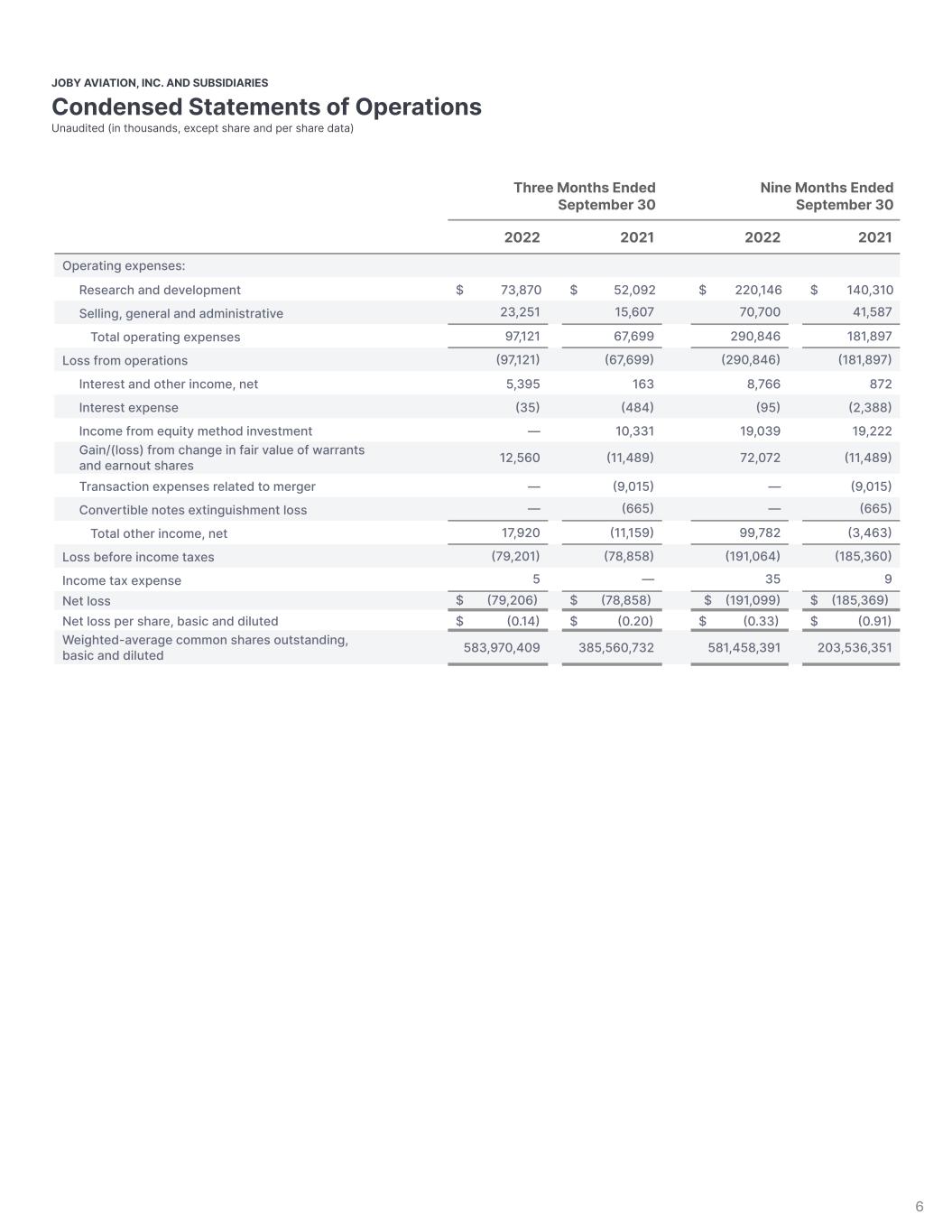
Three Months Ended September 30 Nine Months Ended September 30 2022 2021 2022 2021 Operating expenses: Research and development $ 73,870 $ 52,092 $ 220,146 $ 140,310 Selling, general and administrative 23,251 15,607 70,700 41,587 Total operating expenses 97,121 67,699 290,846 181,897 Loss from operations (97,121) (67,699) (290,846) (181,897) Interest and other income, net 5,395 163 8,766 872 Interest expense (35) (484) (95) (2,388) Income from equity method investment — 10,331 19,039 19,222 Gain/(loss) from change in fair value of warrants and earnout shares 12,560 (11,489) 72,072 (11,489) Transaction expenses related to merger — (9,015) — (9,015) Convertible notes extinguishment loss — (665) — (665) Total other income, net 17,920 (11,159) 99,782 (3,463) Loss before income taxes (79,201) (78,858) (191,064) (185,360) Income tax expense 5 — 35 9 Net loss $ (79,206) $ (78,858) $ (191,099) $ (185,369) Net loss per share, basic and diluted $ (0.14) $ (0.20) $ (0.33) $ (0.91) Weighted-average common shares outstanding, basic and diluted 583,970,409 385,560,732 581,458,391 203,536,351 JOBY AVIATION, INC. AND SUBSIDIARIES Condensed Statements of Operations Unaudited (in thousands, except share and per share data) 6
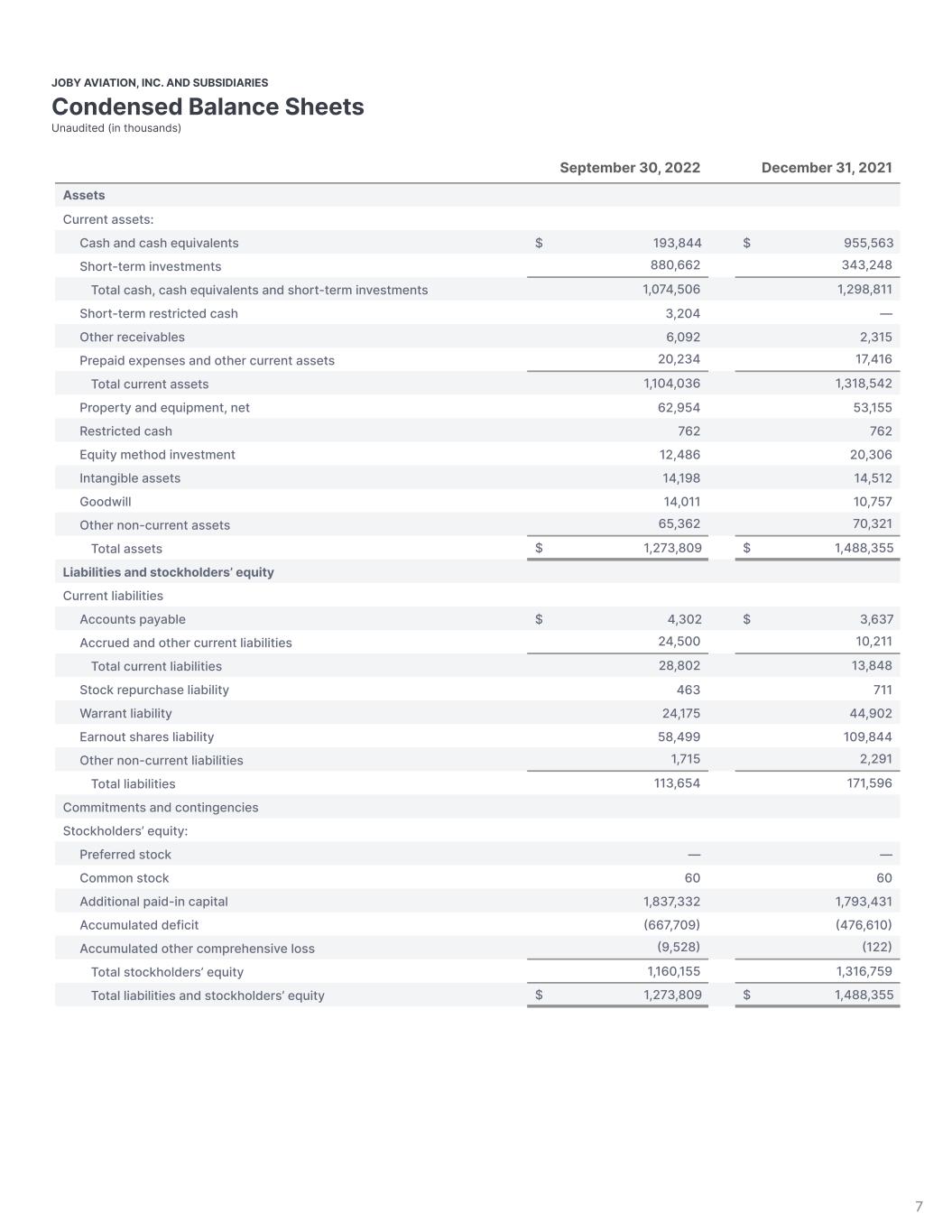
September 30, 2022 December 31, 2021 Assets Current assets: Cash and cash equivalents $ 193,844 $ 955,563 Short-term investments 880,662 343,248 Total cash, cash equivalents and short-term investments 1,074,506 1,298,811 Short-term restricted cash 3,204 — Other receivables 6,092 2,315 Prepaid expenses and other current assets 20,234 17,416 Total current assets 1,104,036 1,318,542 Property and equipment, net 62,954 53,155 Restricted cash 762 762 Equity method investment 12,486 20,306 Intangible assets 14,198 14,512 Goodwill 14,011 10,757 Other non-current assets 65,362 70,321 Total assets $ 1,273,809 $ 1,488,355 Liabilities and stockholders’ equity Current liabilities Accounts payable $ 4,302 $ 3,637 Accrued and other current liabilities 24,500 10,211 Total current liabilities 28,802 13,848 Stock repurchase liability 463 711 Warrant liability 24,175 44,902 Earnout shares liability 58,499 109,844 Other non-current liabilities 1,715 2,291 Total liabilities 113,654 171,596 Commitments and contingencies Stockholders’ equity: Preferred stock — — Common stock 60 60 Additional paid-in capital 1,837,332 1,793,431 Accumulated deficit (667,709) (476,610) Accumulated other comprehensive loss (9,528) (122) Total stockholders’ equity 1,160,155 1,316,759 Total liabilities and stockholders’ equity $ 1,273,809 $ 1,488,355 JOBY AVIATION, INC. AND SUBSIDIARIES Condensed Balance Sheets Unaudited (in thousands) 7
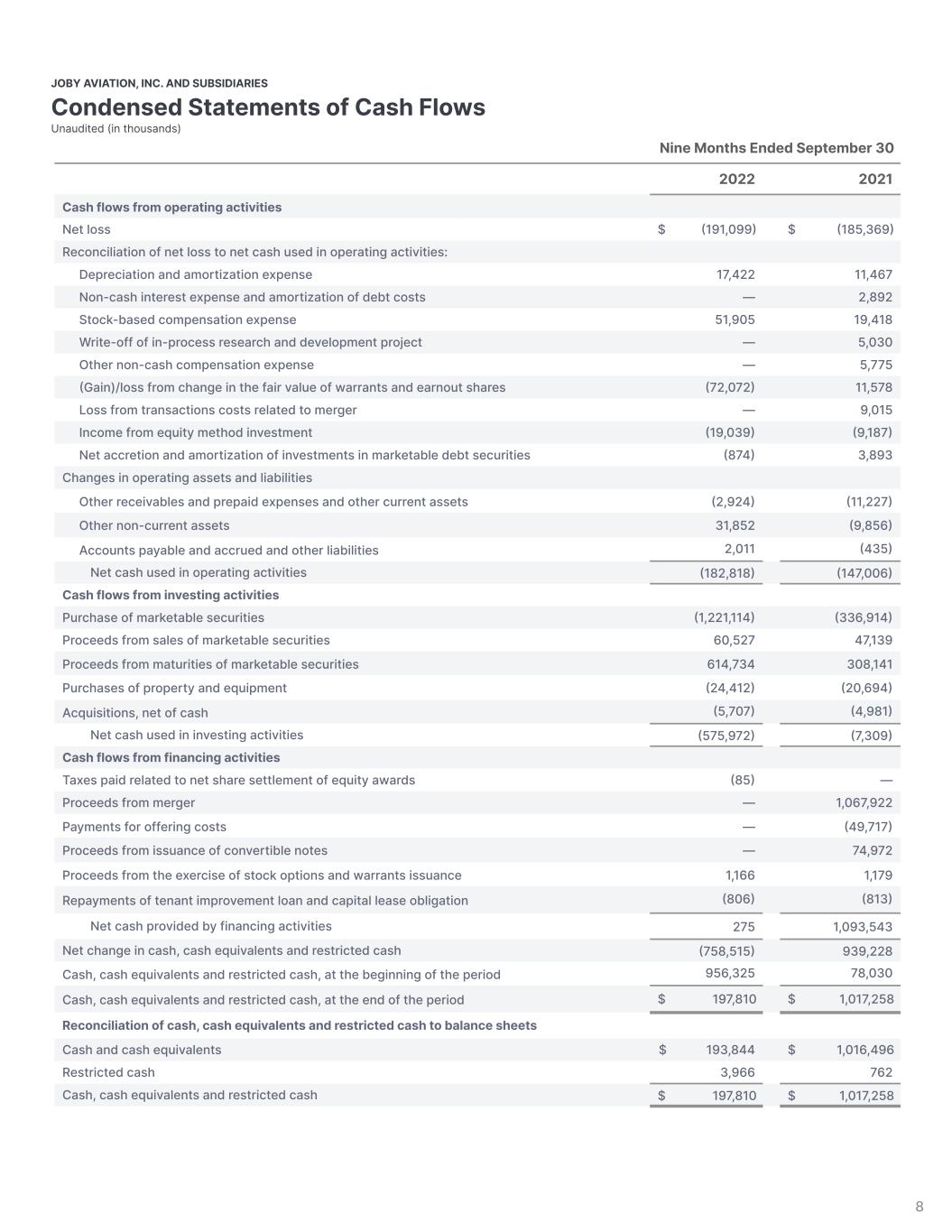
Nine Months Ended September 30 2022 2021 Cash flows from operating activities Net loss $ (191,099) $ (185,369) Reconciliation of net loss to net cash used in operating activities: Depreciation and amortization expense 17,422 11,467 Non-cash interest expense and amortization of debt costs — 2,892 Stock-based compensation expense 51,905 19,418 Write-off of in-process research and development project — 5,030 Other non-cash compensation expense — 5,775 (Gain)/loss from change in the fair value of warrants and earnout shares (72,072) 11,578 Loss from transactions costs related to merger — 9,015 Income from equity method investment (19,039) (9,187) Net accretion and amortization of investments in marketable debt securities (874) 3,893 Changes in operating assets and liabilities Other receivables and prepaid expenses and other current assets (2,924) (11,227) Other non-current assets 31,852 (9,856) Accounts payable and accrued and other liabilities 2,011 (435) Net cash used in operating activities (182,818) (147,006) Cash flows from investing activities Purchase of marketable securities (1,221,114) (336,914) Proceeds from sales of marketable securities 60,527 47,139 Proceeds from maturities of marketable securities 614,734 308,141 Purchases of property and equipment (24,412) (20,694) Acquisitions, net of cash (5,707) (4,981) Net cash used in investing activities (575,972) (7,309) Cash flows from financing activities Taxes paid related to net share settlement of equity awards (85) — Proceeds from merger — 1,067,922 Payments for offering costs — (49,717) Proceeds from issuance of convertible notes — 74,972 Proceeds from the exercise of stock options and warrants issuance 1,166 1,179 Repayments of tenant improvement loan and capital lease obligation (806) (813) Net cash provided by financing activities 275 1,093,543 Net change in cash, cash equivalents and restricted cash (758,515) 939,228 Cash, cash equivalents and restricted cash, at the beginning of the period 956,325 78,030 Cash, cash equivalents and restricted cash, at the end of the period $ 197,810 $ 1,017,258 Reconciliation of cash, cash equivalents and restricted cash to balance sheets Cash and cash equivalents $ 193,844 $ 1,016,496 Restricted cash 3,966 762 Cash, cash equivalents and restricted cash $ 197,810 $ 1,017,258 JOBY AVIATION, INC. AND SUBSIDIARIES Condensed Statements of Cash Flows Unaudited (in thousands) 8
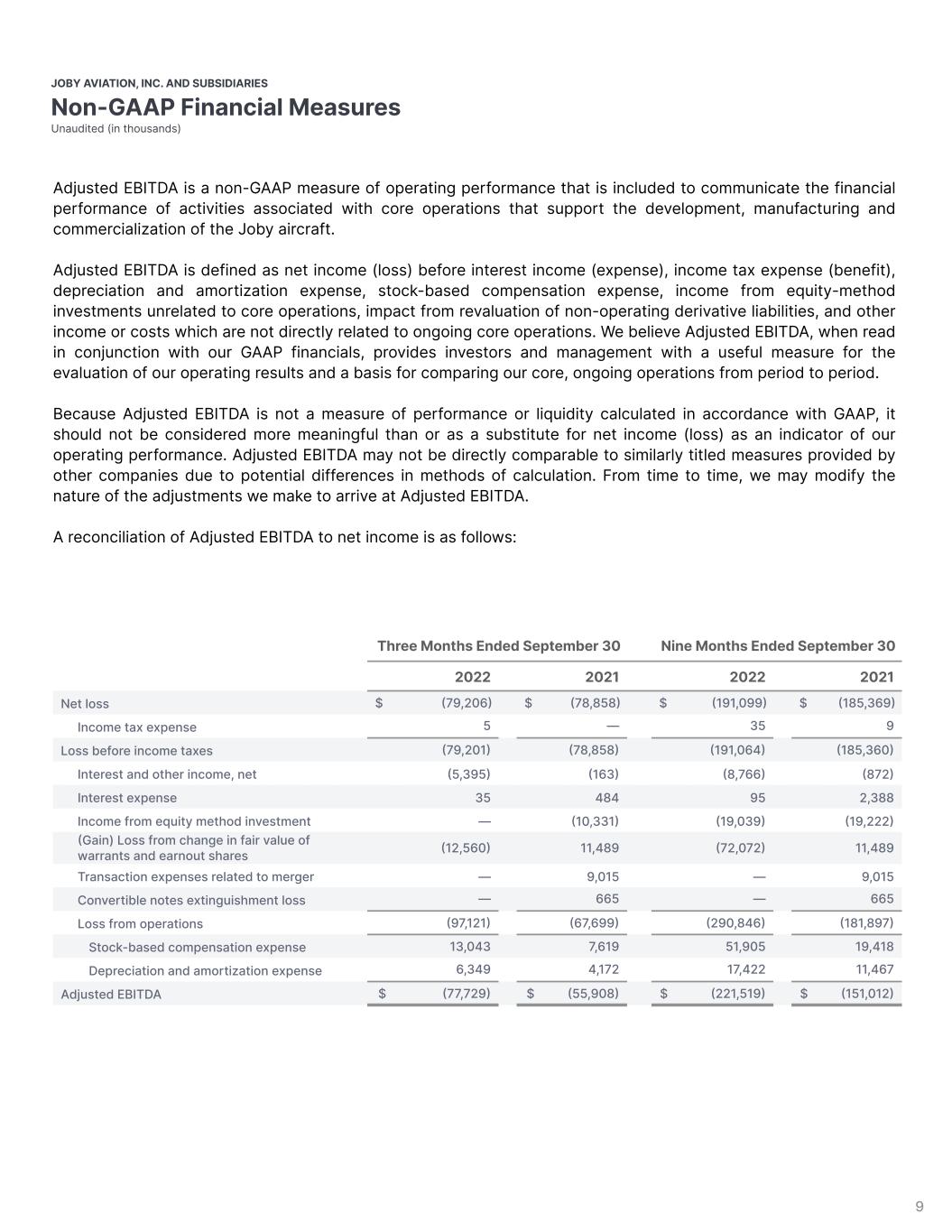
Three Months Ended September 30 Nine Months Ended September 30 2022 2021 2022 2021 Net loss $ (79,206) $ (78,858) $ (191,099) $ (185,369) Income tax expense 5 — 35 9 Loss before income taxes (79,201) (78,858) (191,064) (185,360) Interest and other income, net (5,395) (163) (8,766) (872) Interest expense 35 484 95 2,388 Income from equity method investment — (10,331) (19,039) (19,222) (Gain) Loss from change in fair value of warrants and earnout shares (12,560) 11,489 (72,072) 11,489 Transaction expenses related to merger — 9,015 — 9,015 Convertible notes extinguishment loss — 665 — 665 Loss from operations (97,121) (67,699) (290,846) (181,897) Stock-based compensation expense 13,043 7,619 51,905 19,418 Depreciation and amortization expense 6,349 4,172 17,422 11,467 Adjusted EBITDA $ (77,729) $ (55,908) $ (221,519) $ (151,012) JOBY AVIATION, INC. AND SUBSIDIARIES Non-GAAP Financial Measures Unaudited (in thousands) 9 Adjusted EBITDA is a non-GAAP measure of operating performance that is included to communicate the financial performance of activities associated with core operations that support the development, manufacturing and commercialization of the Joby aircraft. Adjusted EBITDA is defined as net income (loss) before interest income (expense), income tax expense (benefit), depreciation and amortization expense, stock-based compensation expense, income from equity-method investments unrelated to core operations, impact from revaluation of non-operating derivative liabilities, and other income or costs which are not directly related to ongoing core operations. We believe Adjusted EBITDA, when read in conjunction with our GAAP financials, provides investors and management with a useful measure for the evaluation of our operating results and a basis for comparing our core, ongoing operations from period to period. Because Adjusted EBITDA is not a measure of performance or liquidity calculated in accordance with GAAP, it should not be considered more meaningful than or as a substitute for net income (loss) as an indicator of our operating performance. Adjusted EBITDA may not be directly comparable to similarly titled measures provided by other companies due to potential differences in methods of calculation. From time to time, we may modify the nature of the adjustments we make to arrive at Adjusted EBITDA. A reconciliation of Adjusted EBITDA to net income is as follows:
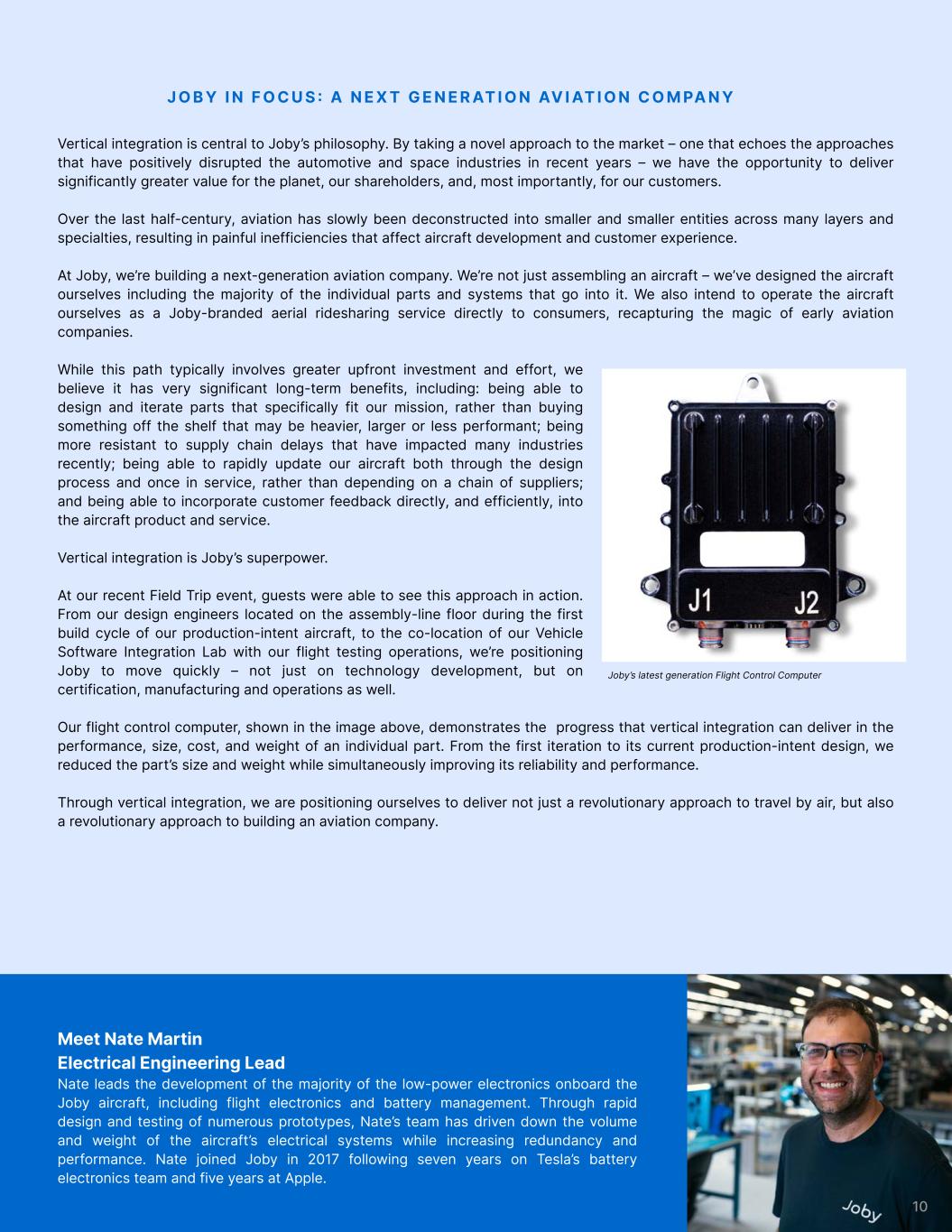
J O B Y I N F O C U S : A N E X T G E N E R AT I O N AV I AT I O N C O M PA N Y Vertical integration is central to Joby’s philosophy. By taking a novel approach to the market – one that echoes the approaches that have positively disrupted the automotive and space industries in recent years – we have the opportunity to deliver significantly greater value for the planet, our shareholders, and, most importantly, for our customers. Over the last half-century, aviation has slowly been deconstructed into smaller and smaller entities across many layers and specialties, resulting in painful inefficiencies that affect aircraft development and customer experience. At Joby, we’re building a next-generation aviation company. We’re not just assembling an aircraft – we’ve designed the aircraft ourselves including the majority of the individual parts and systems that go into it. We also intend to operate the aircraft ourselves as a Joby-branded aerial ridesharing service directly to consumers, recapturing the magic of early aviation companies. While this path typically involves greater upfront investment and effort, we believe it has very significant long-term benefits, including: being able to design and iterate parts that specifically fit our mission, rather than buying something off the shelf that may be heavier, larger or less performant; being more resistant to supply chain delays that have impacted many industries recently; being able to rapidly update our aircraft both through the design process and once in service, rather than depending on a chain of suppliers; and being able to incorporate customer feedback directly, and efficiently, into the aircraft product and service. Vertical integration is Joby’s superpower. At our recent Field Trip event, guests were able to see this approach in action. From our design engineers located on the assembly-line floor during the first build cycle of our production-intent aircraft, to the co-location of our Vehicle Software Integration Lab with our flight testing operations, we’re positioning Joby to move quickly – not just on technology development, but on certification, manufacturing and operations as well. Our flight control computer, shown in the image above, demonstrates the progress that vertical integration can deliver in the performance, size, cost, and weight of an individual part. From the first iteration to its current production-intent design, we reduced the part’s size and weight while simultaneously improving its reliability and performance. Through vertical integration, we are positioning ourselves to deliver not just a revolutionary approach to travel by air, but also a revolutionary approach to building an aviation company. 10 Meet Nate Martin Electrical Engineering Lead Nate leads the development of the majority of the low-power electronics onboard the Joby aircraft, including flight electronics and battery management. Through rapid design and testing of numerous prototypes, Nate’s team has driven down the volume and weight of the aircraft’s electrical systems while increasing redundancy and performance. Nate joined Joby in 2017 following seven years on Tesla’s battery electronics team and five years at Apple. Joby’s latest generation Flight Control Computer
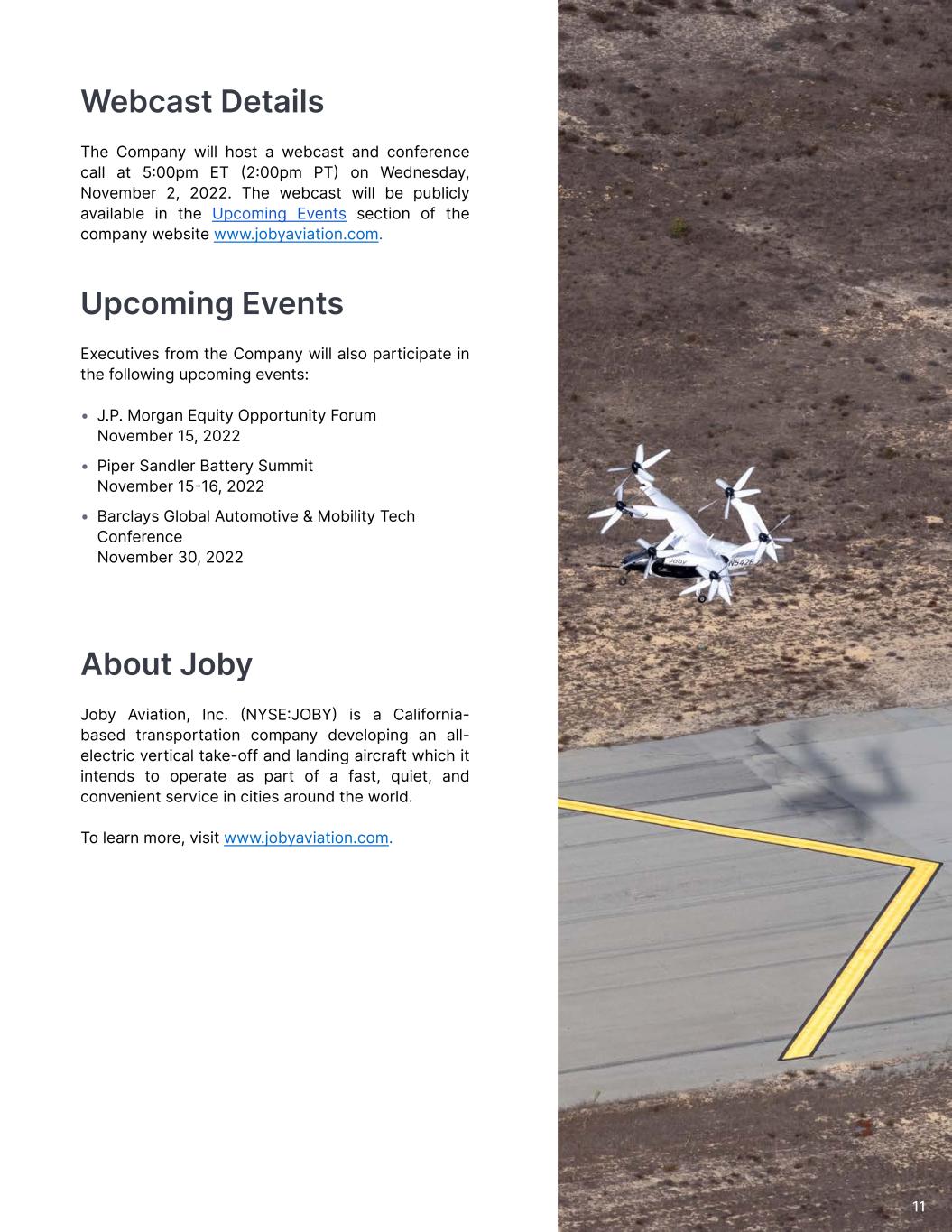
Webcast Details The Company will host a webcast and conference call at 5:00pm ET (2:00pm PT) on Wednesday, November 2, 2022. The webcast will be publicly available in the Upcoming Events section of the company website www.jobyaviation.com. Upcoming Events Executives from the Company will also participate in the following upcoming events: • J.P. Morgan Equity Opportunity Forum November 15, 2022 • Piper Sandler Battery Summit November 15-16, 2022 • Barclays Global Automotive & Mobility Tech Conference November 30, 2022 About Joby Joby Aviation, Inc. (NYSE:JOBY) is a California- based transportation company developing an all- electric vertical take-off and landing aircraft which it intends to operate as part of a fast, quiet, and convenient service in cities around the world. To learn more, visit www.jobyaviation.com. 11
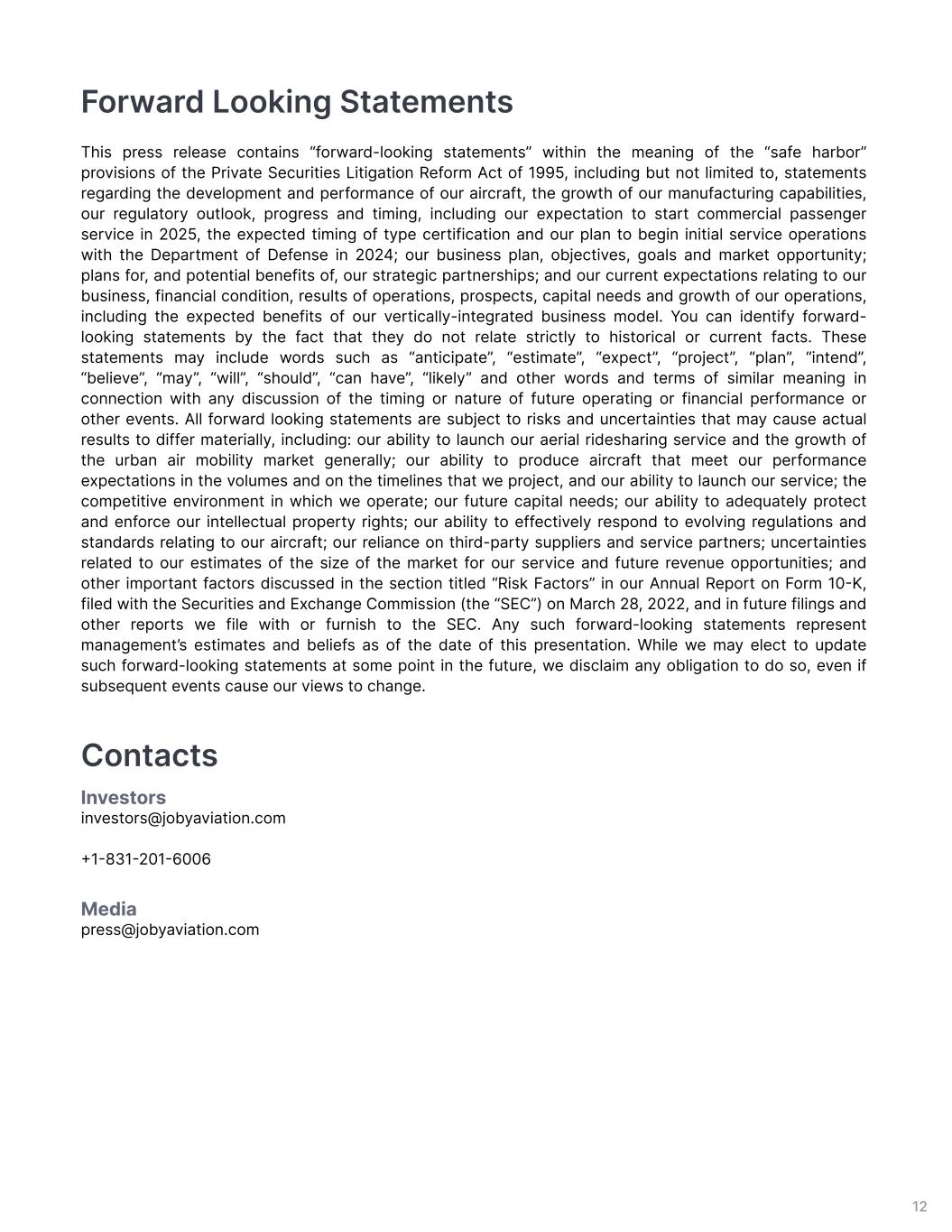
Forward Looking Statements This press release contains “forward-looking statements” within the meaning of the “safe harbor” provisions of the Private Securities Litigation Reform Act of 1995, including but not limited to, statements regarding the development and performance of our aircraft, the growth of our manufacturing capabilities, our regulatory outlook, progress and timing, including our expectation to start commercial passenger service in 2025, the expected timing of type certification and our plan to begin initial service operations with the Department of Defense in 2024; our business plan, objectives, goals and market opportunity; plans for, and potential benefits of, our strategic partnerships; and our current expectations relating to our business, financial condition, results of operations, prospects, capital needs and growth of our operations, including the expected benefits of our vertically-integrated business model. You can identify forward- looking statements by the fact that they do not relate strictly to historical or current facts. These statements may include words such as “anticipate”, “estimate”, “expect”, “project”, “plan”, “intend”, “believe”, “may”, “will”, “should”, “can have”, “likely” and other words and terms of similar meaning in connection with any discussion of the timing or nature of future operating or financial performance or other events. All forward looking statements are subject to risks and uncertainties that may cause actual results to differ materially, including: our ability to launch our aerial ridesharing service and the growth of the urban air mobility market generally; our ability to produce aircraft that meet our performance expectations in the volumes and on the timelines that we project, and our ability to launch our service; the competitive environment in which we operate; our future capital needs; our ability to adequately protect and enforce our intellectual property rights; our ability to effectively respond to evolving regulations and standards relating to our aircraft; our reliance on third-party suppliers and service partners; uncertainties related to our estimates of the size of the market for our service and future revenue opportunities; and other important factors discussed in the section titled “Risk Factors” in our Annual Report on Form 10-K, filed with the Securities and Exchange Commission (the “SEC”) on March 28, 2022, and in future filings and other reports we file with or furnish to the SEC. Any such forward-looking statements represent management’s estimates and beliefs as of the date of this presentation. While we may elect to update such forward-looking statements at some point in the future, we disclaim any obligation to do so, even if subsequent events cause our views to change. Contacts Investors investors@jobyaviation.com +1-831-201-6006 Media press@jobyaviation.com 12
